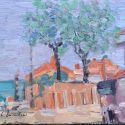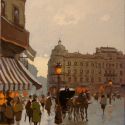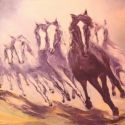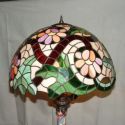
photo:
http://4.bp.blogspot.com/_2fxyzVZCXbg/TQz4frC_A4I/AAAAAAAAKR8/RU8xWVMbYVo/s400/bing-crosby-1949.jpg
Biography
Harry Lillis Crosby was born in Tacoma, Washington on May 3, 1903 in a house that his father built (1112 North J Street, Tacoma, Washington). His family later moved to Spokane, Washington in 1906 to find work. He was the fourth of seven children - five boys Larry (1895-1975), Everett (born 1896), Ted (born 1900) and Bob (1913-1993) and two girls Catherine (born 1905) and Mary Rose (born 1907) - born to English-American Harry Lowe Crosby (1871-1950), a bookkeeper and Irish-American Catherine Harrigan (1873-1964), (affectionately known as Kate), the daughter of a builder from County Mayo in Ireland. His paternal ancestors Thomas Prence and Patience Brewster were born in England and immigrated to the U.S. in the 17th century; Brewster's family came over on the Mayflower.
It should be noted that Bing Crosby had no birth certificate and that his birth date was shrouded in mystery until his childhood Roman Catholic church in Tacoma, Washington, released the baptismal records that revealed his date of birth.
The nickname "Bing" was bestowed upon on him by a childhood friend, Valentine Hobart, who shared Bing's interest in a newspaper comic strip called "The Bingville Bugle". Valentine Hobart began calling Harry Crosby "Bingo from Bingville." Eventually the nickname was shortened to "Bing" and was adopted by Bing's other friends and even his teachers.
Bing Crosby's parents loved music and they both loved to sing. Bing was even sent away to singing lessons, but dropped out because he did not like the demands of the training. Bing's favorite singer and idol was Al Jolson. However, Bing's style is quite different from Jolson's loud, high volume approach to singing.
Bing enrolled in the Jesuit-run Gonzaga College in Spokane, Washington in the fall of 1920 with the intent to become a lawyer. While in Gonzaga he sent away for a set of mail order drums. After much practice he soon became good enough and was invited to join a local band which was made up of mostly local high school kids called the "Musicaladers", managed by one Al Rinker. He made so much money doing this he decided to drop out of school during his final year, to pursue a career in show business.
Popular success
Bing Crosby at the 1944 Academy Awards with the Best Actor Oscar for Going My Way.
In 1926, Crosby caught the eye of Paul Whiteman (who promoted himself as The King of Jazz) while singing on the vaudeville in Los Angeles. Hired to join one of the most popular bands in America, the fledgling vocalist would receive a musical education from the greatest musicians of the era. Unlike the typical vaudeville "shouters," he learned to work the microphone (and the crowd) drawing the audience in with his smooth, gentle style.
He was thus able to take popular singing beyond the kind of "belting" associated with a performer like Al Jolson, who had to reach the back seats in New York theatres without the aid of the microphone. With Crosby, as Henry Pleasants noted in The Great American Popular Singers, something new had entered American music, something that might be called "singing in American," with conversational ease. The oddity of this new sound led to the epithet "crooner".
Bing soon became the star attraction of the band and sang Whiteman's biggest hit of 1928, "Ol' Man River." However, his repeated youthful peccadilloes forced Whiteman to fire him 1930. Crosby had no desire to step out on his own, but was now forced into a solo career.
In early 1931, Bing landed his first hit under his own name with "I Surrender, Dear." He contined to chart throughout the year with "Out Of Nowhere," "Just One More Chance," "Wrap your Troubles In Dreams" and "I Found A Million Dollar Baby." Crosby became so popular that Mack Sennett (of Keystone Kops fame) signed him up for six two reelers, each based on one of his songs. (Today this is Redistributed under the title of "Road to Hollywood.")
That same year (1931), Bing made his solo debut, co-starring with The Carl Fenton Orchestra on a popular CBS radio show and by 1936, replaced his former boss, Paul Whiteman, as the host of NBC's Kraft Music Hall, a weekly radio program where he would remain for the next ten years.
Crosby's entertainment trifecta led to major motion picture contract with Paramount Pictures beginning with The Big Broadcast Of 1932. This led to his appearances in 79 Movies, 55 of which he was top billed.
During the War, Crosby gave great emphasis to live appearances before American troops fighting in the European Theater. He also learned how to pronounce German from written scripts, and would read them in propaganda broadcasts intended for the German forces. The nickname "der Bingle" for him was understood to have become current among German listeners, and came to be used by his English-speaking fans. In a poll of U.S. troops at the close of WWII, Crosby topped the list as the person who did the most for G.I. morale (beating out Franklin Delano Roosevelt, Dwight Eisenhower and one Leslie Townes "Bob Hope".)
Crosby's biggest musical hit was his recording of Irving Berlin's "White Christmas", which he introduced through a 1941 Christmas-season radio broadcast and the movie Holiday Inn. Bing's recording hit the charts on Oct. 3, 1942, and rose to #1 on Oct. 31, where it stayed for an amazing 11 weeks. In the following years Bing's recording hit the top-30 pop charts another 16 times, even topping the charts again in 1945 and January of '47. The song remains Bing's best-selling recording, and the best-selling Christmas single and second best selling song of all time with estimates between 30 to 45 million albums sold. In 1998 after a long absence, his 1947 version hit the charts in Britain, and as of 2006 remains the North American holiday-season standard. According to Guinness World Records, Bing Crosby's White Christmas has "sold over 100 million copies around the world, with at least 50 million sales as singles.[1]
Golfballs for the Scrap Rubber Drive during WWII.
Crosby also had regular radio shows from the 1930s through the 1950s. During the 1940s he recorded many songs with the Andrews Sisters. He starred in a network television sitcom in 1964 and 1965, and made numerous short films and television appearances.
Vocal characteristics
The strength of Bing Crosby's voice is that, while he sang loud and soft, he made it seem as though he was never trying too hard, like the song was merely an extension of regular conversation. Most fans separate Bing Crosby's voice into three distinct eras. During the first, in the 1930's, he sang in a low tenor register and, according to Ken Barnes "had a wonderful soaring quality in those days, but was loaded with mannerisms that even Bing himself grew tired of." His second "vocal era" occurred during his peak years of the 1940's and early 1950's when Bing perfected his style and his voice matured into a warm, lush baritone, which, according to Louis Armstrong "was like gold being poured out of a cup."[2] The third, and final, "vocal era" was from about 1955 onward, during which Crosby lost his high notes while gaining low notes, though he could still nudge two octaves. Ken Barnes described Crosby's low notes as "gloriously roomy and immensly powerful" while Mel Torme wrote, in his book "My Singing Teachers" (Oxford University Press) that "Bing Crosby sang with an unmatched resonance ... His low notes could make your bass woofers beg for mercy." Bing Crosby's vocal range is best illustrated by, Henry Pleasants, a leading vocal critic. "The octave B flat to B flat in Bing's voice at that time [1930s] is, to my ears, one of the loveliest I have heard in forty-five years of listening to baritones, both classical and popular. It dropped conspicuously in later years. Since the mid-1950s, Bing has been more comfortable in a bass range while maintaining a baritone quality, with the best octave being G to G, or even F to F. In a recording he made of 'Dardanella' with Louis Armstrong in 1960, he attacks lightly and easily on a low E flat. This is lower than most opera basses care to venture, and they tend to sound as if they were in the cellar when they get there. (Pleasants, The Great American Popular Singers, p132)
Career statistics
Bing Crosby has sales statistics that would place him among the most popular and successful musical acts of the 20th century, and would also suggest that Bing Crosby played a central role in American cultural and musical history. 1,700 recordings, 383 of those in the top 30, and of those, 41 hit No. 1. For 15 years (1934, 1937, 1940, 1943-1954) he was among the top 10 in box office draw, and for five of those years (1944-49) he was the largest in the world. He sang four Academy Award-winning songs - "Sweet Leilani" (1937), "White Christmas" (1942), "Swinging on a Star" (1944), "In the Cool, Cool, Cool of the Evening" (1951) - and won an acting Oscar for Going My Way (1944). He also collected 23 gold and platinum records which is quite amazing considering gold and platinum records did not come into existence until 1958, after which Crosby was considered retired. In 1962 Crosby became the first recipient of the Grammy Lifetime Achievement Award, a list that now contains a plethora of musical legends. He has been inducted into the respective halls of fame for both radio and popular music. His music sales are estimated at between 500 000 000 (Five Hundred Million) to 900 000 000 (Nine Hundred Million).
Mass Media
Bing Crosby's desire to pre-record his radio shows, combined with a dissatisfaction with the available aluminum recording disks, was a significant factor in the development of magnetic tape recording and the radio industry's adoption of it. He used his power to innovate new methods of reproducing himself. In 1946 he wanted to shift from live performance to recorded transcriptions for his weekly radio show on NBC sponsored by Kraft. But NBC refused to allow recorded radio programs (except for advertisements). The live production of radio shows was a deeply-established tradition reinforced by the ASCAP union. The new ABC network, formed out of the sale of the old NBC Blue network in 1943 to Edward Noble, the "Lifesaver King," was willing to break the tradition. It would pay Crosby $30,000 per week to produce a recorded show every Wednesday sponsored by Philco. He would also get $40,000 from 400 independent stations for the rights to broadcast the 60-minute show that was sent to them every Monday on three 16-inch aluminum discs that played 10 minutes per side at 33-1/3 rpm. Crosby wanted to change to recorded production for several reasons. The legend that has been most often told is that it would give him more time for his golf game. And he did record his first Philco program in August 1947 so he could enter the Jasper National Park Invitational Gold Tournament in September when the new radio season was to start. But golf was not the most important reason. Crosby was always an early riser and hard worker. He sought better quality through recording, not more spare time. He could eliminate mistakes and control the timing of performances. Because his own Bing Crosby Enterprises produced the show, he could purchase the latest and best sound equipment and arrange the microphones his way (mic placement had long been a hotly-debated issue in every recording studio since the beginning of the electrical era). No longer would he have to wear the hated toupee on his head previously required by CBS and NBC for his live audience shows (Bing preferred a hat). He could also record short promotions for his latest investment, the world's first frozen orange juice to be sold under the brand name Minute Maid.
Bing Crosby with the first audio tape recorder, The Ampex Model 200, which was first used to record his radio show on April 25, 1948.
The transcription method however had problems. The 16-inch aluminum program discs were made from master discs running at 78 rpm and holding only 4 minutes per side. This presented editing and timing problems that often caused gaps or glitches in the flow of the 60-minute program. Also, the acetate surface coating of the aluminum discs was little better than the wax that Edison had used at the turn of the century, with the same limited dynamic range and frequency response. In June of 1947, Murdo MacKenzie of Crosby Enterprises saw a demonstration of the German Magnetophone that Jack Mullin had brought back from Radio Frankfurt with 50 reels of tape at the end of the war. This machine was one of the magnetic tape recorders that BASF and AEG had built in Germany starting in 1935. The 1/2 inch ferric-coated tape could record 20 minutes per reel of high-quality sound. Alexander M. Poniatoff ordered his Ampex company (founded in 1944 from his initials A.M.P. plus the starting letters of "excellence") to manufacture an improved version of the Magnetophone.
Bing Crosby hired Mullin and his German machine to start recording his Philco show in August 1947 with the same 50 reels of German magnetic tape that Mullin had found in Frankfort. The crucial advantage was editing. As Bing wrote in his autobiography, "By using tape, I could do a thirty-five or forty-minute show, then edit it down to the twenty-six or twenty-seven minutes the program ran. In that way, we could take out jokes, gags, or situations that didn't play well and finish with only the prime meat of the show; the solid stuff that played big. We could also take out the songs that didn't sound good. It gave us a chance to first try a recording of the songs in the afternoon without an audience, then another one in front of a studio audience. We'd dub the one that came off best into the final transcription. It gave us a chance to ad lib as much as we wanted, knowing that excess ad libbing could be sliced from the final product. If I made a mistake in singing a song or in the script, I could have some fun with it, then retain any of the fun that sounded amusing." Mullin's 1976 memoir of these early days of experimental recording agrees with Bing's account: "In the evening, Crosby did the whole show before an audience. If he muffed a song then, the audience loved it - thought it was very funny - but we would have to take out the show version and put in one of the rehearsal takes. Sometimes, if Crosby was having fun with a song and not really working at it, we had to make it up out of two or three parts. This ad-lib way of working is commonplace in the recording studios today, but it was all new to us."
Crosby also invested in Ampex to produce more machines. In 1948, the second season of Philco shows was taped with the new Ampex Model 200 tape recorder (introduced in April) using the new Scotch 111 tape from the Minnesota Mining and Manufacturing company. Mullin explained that new techniques were invented on the Crosby show with these machines: "One time Bob Burns, the hillbilly comic, was on the show, and he threw in a few of his folksy farm stories, which of course were not in Bill Morrow's script. Today they wouldn't seem very off-color, but things were different on radio then. They got enormous laughs, which just went on and on. We couldn't use the jokes, but Bill asked us to save the laughs. A couple of weeks later he had a show that wasn't very funny, and he insisted that we put in the salvaged laughs. Thus the laugh-track was born." Crosby had launched the tape recorder revolution in America. In his 1950 film Mr. Music, Bing Crosby can be seen singing into one of the new Ampex tape recorders that reproduced his voice better than anything else. Also quick to adopt tape recording was his friend Bob Hope, who would make the famous "Road to..." films with Bing and Dorothy Lamour.
Mullin continued to work for Crosby to develop a videotape recorder. Television production was mostly live in its early years but Crosby wanted the same ability to record that he had achieved in radio. The Fireside Theater sponsored by Proctor and Gamble was his first television production for the 1950 season. Mullin had not yet succeeded with videotape, so Crosby filmed the series of 26-minute shows at the Hal Roach Studios. The "telefilms" were sent to television stations and projected into a camera using a film chain. This would be the same method used by Desi Arnaz in 1951 for the production of the I Love Lucy sitcom and Desilu became the industry model for the independent syndication of filmed episodic series. Crosby did not remain a television producer but continued to finance the development of videotape. Mullin would demonstrate a blurry picture on December 30, 1952, but he was not able to solve the problem of high tape speed. It was the Ampex team led by Charles Ginsburg that made the first videotape recorder. Rather than speeding tape across fixed heads at 30 mph, Ginsburg used rotating heads to record at a slant on tape moving at only 15 ips. The helical scan model VR-1000 was demonstrated at the NAB show in Chicago on April 14, 1956, and was an immediate success. Ampex made $4 million in sales during the NAB convention and by 1957 most TV production was done on videotape. Ampex developed a color videotape system in 1958 and recorded the spirited debate between Khrushchev and Nixon on a demonstration model at the Moscow trade Fair September 25, 1959. By this time, Crosby had sold his videotape interests to the 3M company and no longer played the role of tape recorder pioneer. Yet his contribution had been crucial. He had opened the door to Mullin's machine in 1948 and financed the early years of the Ampex company. The rapid spread of the tape recorder revolution was in no small measure caused by Crosby's efforts.
The decade following the end of World War II witnessed what has been called the "revolution in sound." The Decca Company introduced FFRR 78 rpm records (Full Frequency Range Recording) that had the finest frequency response (80-15,000 cps) of any recording process before magnetic tape recording. Decca's method of reducing the size of the groove and designing a delicate elliptical stylus to track on the sides of the groove would be the same innovation of the new microgroove process introduced by Columbia in 1948 on the new 33-1/3 rpm LP vinyl record. Crosby's sponsor Philco would join Columbia in selling a new $29.95 record player with jeweled stylus (not steel) tracking at only 10 grams (not 200) for these LPs. No longer would records wear out after 75 plays. Crosby's Ampex Company would be joined by Magnecord, Webcor, Revere, and Fairchild in selling one million tape recorders to a rapidly growing consumer audio component market by 1953. The 1949 Magnecord tape recorder had stereo capability eight years before any vinyl record had it. These components soon began to feature the transistor invented by Bell Labs in 1948. Crosby's 1942 film Holiday Inn (where he first sang his most famous song) would be remade in 1954 as White Christmas, the first film to use Paramount's new VistaVision wide-screen film process with multi-channel magnetic sound.
Personal life
Bing Crosby with his first wife Dixie Lee.
Crosby was married twice, first to actress/nightclub singer Dixie Lee from 1930 until her death from ovarian cancer in 1952. They had four sons (Gary, Dennis, Phillip and Lindsay). Dixie was an alcoholic, and the 1947 film Smash-Up: The Story of a Woman is indirectly based on her life. After Dixie's death, Bing married the much-younger actress Kathryn Grant in 1957 and they had three children together, Harry, Mary (best known for portraying the woman who shot J.R. Ewing on Dallas) and Nathaniel.
After Bing's death from a heart attack at age 74 while golfing in Madrid, Spain, his eldest son, Gary, wrote a highly critical memoir (Going My Own Way) depicting Bing as cold, remote, and both physically and psychologically abusive. As is often the case in these situations, one sibling sides with the parent. In this case, it was Phillip, who later frequently disputed his brother Gary's claims about their father. In an interview conducted in 1999 by the Globe, Phillip is quoted as saying, "My dad was not the monster my lying brother said he was, He was strict, but my father never beat us black and blue and my brother Gary was a vicious, no-good liar for saying so. I have nothing but fond memories of dad, going to studios with him, family vacations at our cabin in Idaho, boating and fishing with him. To my dying day, I'll hate Gary for dragging dad's name through the mud. He wrote [Going My Own Way] out of greed. He wanted to make money and knew that humiliating our father and blackening his name was the only way he could do it. He knew it would generate a lot of publicity and that was the only way he could get his ugly, no-talent face on television and in the newspapers. My dad was my hero. I loved him very much. And he loved all of us too, including Gary. He was a great father." Phillip died in 2004 of a heart attack.
Two of Bing's children, Lindsay and Dennis , committed suicide. It was widely published at the time of Lindsay's December 11, 1989 death that he ended his life the day after watching his father sing "White Christmas" on television. Dennis ended his life two years later, grieving over his brother's death, and battered, just as his brother had been, by alcoholism, failed relationships, and lackluster career. Both brothers were subsisting on small allowances from their father's trust fund; both died of self-inflicted gunshot wounds to the head.
Denise Crosby, Dennis' daughter, is also an actress and best known for her role as Tasha Yar on Star Trek: The Next Generation.
Nathaniel Crosby, Bing's youngest son from his second marriage, was a high-level golfer who won the U.S. Amateur at age 19 in 1981, becoming the youngest-ever winner of that event (a record later broken by Tiger Woods).
At his death, Bing was worth over $150 million USD due to his shrewd investments in oil, real estate, and other commodities, making him one of Hollywood's then wealthiest residents along with Fred MacMurray and best friend Bob Hope. He left a clause in his will stating that his sons from his first marriage could not collect their inheritance money until they were in their 80s. Bing felt that they had already been amply taken care of by a trust fund set up by their mother, Dixie Lee. All four sons continued to collect monies from that fund until their deaths. However, none lived long enough to collect any of their inheritance from their father.
NOTE: Due to instructions from his family, the year of birth engraved on Bing Crosby's tombstone is 1904, rather than the correct date, 1903.
Trivia
Parody on Bing Crosby's supposed autocratic parenthood on Family Guy
Bing Crosby possesses the most recorded human voice in history (Schwartz, 1995).
Just after World War Two a Yank Magazine poll declared him the person who had done the most for G.I. morale during the war.
He turned down an offer to play "Columbo" because he didn't want it to interfere with his golf schedule.
Crosby recorded
Bing Crosby died after a round of eighteen holes in which he shot a respectable 85 and won the match. Of his death, biographer Giddins has written: "His last words were characteristic. Walking off the eighteenth green of the La Moraleja Golf Club, in a suburb of Madrid, Bing Crosby said, 'That was a great game of golf, fellas,' and then took a few steps and was gone"2. Shortly after 6:00 p.m. October 14, 1977, he suffered a massive heart attack. Although these were reported as having been Crosby's last words, it is believed that his actual last words were, "Let's go get a Coke." Crosby was interred in the Holy Cross Cemetery in Culver City, California.
"I rate him [Bing Crosby] in the top ten of all actors. He'd do anything and do it well." Frank Capra (Thompson, p243)
Filmography
The King of Jazz (1930)
Two Plus Fours (1930) (short subject)
Check and Double Check (1930)
Reaching for the Moon (1930)
The March of Time (1930) (unfinished)
Confessions of a Co-Ed (1931)
One More Chance (1931) (short subject)
Billboard Girl (1932) (short subject)
Hollywood on Parade (1932) (short subject)
The Big Broadcast (1932)
Hollywood on Parade No. 11 (1933) (short subject)
Blue of the Night (1933) (short subject)
Dream House (1933) (short subject)
Sing, Bing, Sing (1933) (short subject)
Hollywood on Parade No. 9 (1933) (short subject)
College Humor (1933)
Too Much Harmony (1933)
Please (1933) (short subject)
Going Hollywood (1933)
Just an Echo (1934) (short subject)
We're Not Dressing (1934)
I Surrender Dear (1934) (short subject)
She Loves Me Not (1934)
Star Night at the Cocoanut Grove (1934) (short subject)
Here Is My Heart (1934)
Mississippi (1935)
Two for Tonight (1935)
The Big Broadcast of 1936 (1935)
Anything Goes (1936)
Rhythm on the Range (1936)
Pennies from Heaven (1936)
Waikiki Wedding (1937)
Double or Nothing (1937)
Don't Hook Now (1938) (short subject)
Dr. Rhythm (1938)
Hollywood Handicap (1938) (short subject)
Sing You Sinners (1938)
Screen Snapshots: Stars on Horseback (1939) (short subject)
Paris Honeymoon (1939)
East Side of Heaven (1939)
The Star Maker (1939)
Road to Singapore (1940)
Screen Snapshots Series 19, No. 6 (1940) (short subject)
Swing with Bing (1940) (short subject)
Rhythm on the River (1940)
If I Had My Way (1940)
Angels of Mercy (1941) (short subject)
Road to Zanzibar (1941)
Birth of the Blues (1941)
My Favorite Blonde (1942) (Cameo)
Holiday Inn (1942)
Road to Morocco (1942)
Star Spangled Rhythm (1942)
Show Business at War (1943) (short subject)
Dixie (1943)
Going My Way (1944)
Road to Victory (1944) (short subject)
The Princess and the Pirate (1944) (Cameo)
Here Come the Waves (1944)
The All-Star Bond Rally (1945) (short subject)
Duffy's Tavern (1945)
Hollywood Victory Caravan (1945) (short subject)
The Bells of St. Mary's (1945)
Screen Snapshots: Hollywood Celebrations (1945) (short subject)
Road to Utopia (1946)
Screen Snapshots: Famous Fathers and Sons (1946) (short subject)
Blue Skies (1946)
My Favorite Brunette (1947) (Cameo)
Welcome Stranger (1947)
Variety Girl (1947)
Road to Rio (1947)
The Emperor Waltz (1948)
A Connecticut Yankee in King Arthur's Court (1949)
Screen Snapshots: Hollywood's Happy Homes (1949) (short subject)
Jolson Sings Again (1949) (voice only)
Top o' the Morning (1949)
The Adventures of Ichabod and Mr. Toad (1949) (voice)
Alberta Vacation (1950) (short subject)
Riding High (1950)
Screen Actors (1950) (short subject)
Mr. Music (1950)
You Can Change the World (1951) (short subject)
Here Comes the Groom (1951)
Angels in the Outfield (1951) (Cameo)
The Greatest Show on Earth (1952) (Cameo)
Son of Paleface (1952) (Cameo)
Just for You (1952)
Crusade for Prayer (1952) (short subject)
Road to Bali (1952)
Off Limits (1953) (appears on a TV)
Scared Stiff (1953) (Cameo)
Little Boy Lost (1953)
White Christmas (1954)
The Country Girl (1954)
Hollywood Mothers and Fathers (1955) (short subject)
Showdown at Ulcer Gulch (1956) (short subject)
Bing Presents Oreste (1956) (short subject)
Anything Goes (1956)
High Society (1956)
The Heart of Show Business (1957) (short subject)
Man on Fire (1957)
The Legend of Sleepy Hollow (1958) (short subject) (voice)
Alias Jesse James (1959) (Cameo)
Say One for Me (1959)
Let's Make Love (1960) (Cameo)
High Time (1960)
Pepe (1960) (Cameo)
The Road to Hong Kong (1962)
Robin and the 7 Hoods (1964)
Cinerama's Russian Adventure (1966) (documentary) (narrator)
Stagecoach (1966)
Bing Crosby's Washington State (1968) (short subject)
The World of Sport Fishing (1972) (documentary)
Cancel My Reservation (1972) (Cameo)
Just One More Time (1974) (short subject)
That's Entertainment! (1974) (narrator)
Television Work
The Bing Crosby Show (1954)
The Edsel Show (1957)
Bing Crosby in London (1961)
The Bing Crosby Show (1964-1965)
Bing Crosby in Dublin (1965)
Goldilocks (1971) (voice)
Dr. Cook's Garden (1971)
Bing Crosby and Fred Astaire: A Couple of Song and Dance Men (1975)
The Bell Telephone Jubilee (1976)
Discography
These Are Crosby's Gramophone records or LPs.
Bing Crosby's album White Christmas has not been out of print since 1954 and has entered the Billboard Top 40 charts 5 times including multiple times in the top five.
1953 Le Bing: Song Hits of Paris
1953 Some Fine Old Chestnuts
1954 White Christmas soundtrack (w/ Peggy Lee and Danny Kaye)
1954 Bing: A Musical Autobiography
1956 High Society
1956 Songs I Wish I Had Sung the First Time Around
1956 Bing Sings Whilst Bregman Swings
1957 Bing with a Beat
1957 New Tricks
1958 Fancy Meeting You Here ( w/ Rosemary Clooney)
1959 How the West was Won
1959 Join Bing and Sing Along
1960 El Senor Bing
1960 Bing and Satchmo
1960 101 Gang Songs
1961 Holiday in Europe
1962 On the Happy Side
1962 I Wish You a Merry Christmas
1963 Return to Paradise Islands
1963 Great Country Hits
1964 That Traveling Two-Beat (w/ Rosemary Clooney)
1965 The Songs I Love
1968 Thoroughly Modern Bing
1968 The Songs I Love
1968 Hey Jude Hey Bing
1971 A Time to Be Jolly
1972 Bing 'n' Basie
1975 A Southern Memoir
1975 That's What Life Is All About
1975 Bingo Viejo
1975 A Couple of Song and Dance Men
1976 Bing Crosby Live at the London Palladium
1976 At My Time of Life
1976 Feels Good Feels Right
1976 Beautiful Memories
1977 Seasons
Samples
Download sample of "White Christmas"
References
Giddins, Gary. A Pocketful of Dreams: The Early Years, 1903-1940. Boston, New York, & London: Little, Brown and Company, 2001. ISBN 0316886459
A Pocketful of Dreams, p. 259
A Pocketful of Dreams, p. 3
The Steven Lewis Internet Museum
iTunes Essentials - Bing Crosby
Bing Crosby, Elvis Presley Comparison Page
Bing Crosby sales estimates
Bing Crosby sales estimates
Technolgical Influence

































